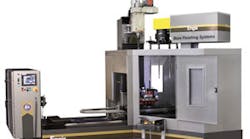Manufacturers of large hydraulic valve bodies know their products must maintain exceptional standards for precision, consistency, and quality in order to succeed in a global market like earth-moving equipment and construction machinery, which demands product performance and quality in component parts.
Engis Corporation’s new FPM-3X is able to finish-bore valves to a precise consistent cylindricity and diameter. Engis supplies superabrasive finishing systems and high-precision micron diamond and CBN powders. Its products are used for grinding, honing, lapping, and polishing, and it also supplies customized, fully configured manufacturing systems for numerous industrial sectors.
For hydraulic valve manufacturers, precision finishing is particularly challenging — especially the part that involves aligning and finishing the bores once the bodies have been stacked. Typically, metalcasters or machine shops will finish each valve individually and then stack the finished pieces together. Unfortunately, the torque that this applies to the stack of valves distorts bore geometry.
The solution that Engis engineered is a three axis, single-pass bore finishing system. According to the supplier, the FPM-3X can finish stacked valve body bores to a cylindricity of 2 microns and a diameter of +/- 1 micron, including those with multiple bores and bores of different diameters. For honing hydraulic valves made to operate in heavy equipment, the FPM-3X offers greater accuracy compared to conventional honing machines and greater flexibility compared to index-style machines.
The FPM-3X features full CNC controls with a Z-stroke of 750 mm, an X-stroke of 1,066 mm and a Y-stroke of 100 mm. The slide base can accommodate parts up to 3,000 lbs. An 8=13 pocket automatic tool changer allows the machine to complete bores from rough to finish without operator involvement. Programming is done via standard G-code.
Using a systems approach, Engis helps manufacturers to optimize bore finishing results by selecting the best combination of superabrasives, tool design, tool holding, part fixturing, cooling/filtration and automation package options.
“Valves are the heart of heavy equipment hydraulics,” stated Engis product manager Robert Marvin. “They coordinate the flow of fluid. Bores with cylindricity problems may experience fluid leakage, premature wear or other failures.”
The FPM-3X makes it possible to finish-bore the valves after stacking, which improves cylindricity and roundness. To locate the bore precisely under the BT-40 spindle, the FPM-3X uses a wireless Renishaw CMM probe to establish the bore location; position information is automatically translated into G-code coordinates.
Marvin noted that the FPM-3X also addresses other shortcomings of standard bore finishing practices. One approach is to finish the bores on a large indexing machine or in a series of machining cells.
“These options offer good accuracy and throughput, but are usually dedicated to high-volume part runs,” he said. “Conversely, the FPM-3X provides significant flexibility. An operator can run a one-off part and change to another part fairly quickly. For companies that want to finish a variety of different parts, the FPM-3X significantly reduces downtime.”
The FPM-3X also increases quality compared to conventional bore honing, where the abrasive tool expands. Engis’ single-pass process removes material by using progressively larger tools in ever-reducing increments with progressively finer diamond size. Table 1 outlines a typical hydraulic stack valve application from an actual case study.
“Most stack valves are between 100 and 300 mm,” he said. “To straighten a bore that has a ‘banana’ shape in it, we need to have diamond tools that are longer than the entire bore to span it. Most machine centers don’t have capacity for that stroke length or sufficient depth between part and spindle, but the FPM-3X does.”
It’s also notable that in other applications the Engis single-pass process can produce bore geometries to within one-half micron (0.000020 in.) of required bore size by increasing the number of tool passes and reducing diamond size.








